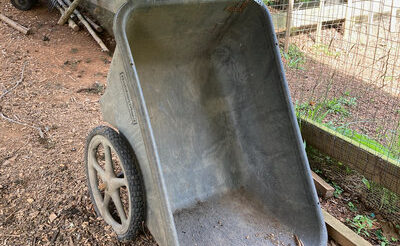New Center for Materials Innovation Developing Self-Healing Plastics

Plastic is useful stuff, until it breaks. We’ve all had to throw something out (you can tell yourself it actually got recycled, if it makes you feel better) where most of it was fine but the object lost its utility due to a single crack.
Here’s an image of a wheelbarrow on our farm. It’s in constant use and has outlived our metal ones, since it doesn’t rust. However, plastic is prone to cracking, and you can see where my wife has repeatedly patched it. Sadly we know it’s just a matter of time before the material fails altogether.
Repairable plastic would be ideal, for the sake of utility, sustainability and economics. As it turns out, the University of Michigan has opened a new Center for Materials Innovation, where researchers and students will develop “material solutions to problems facing society,” and one of those problems is relevant to our wheelbarrow. One of the CMI’s targets is to develop a new sort of repairable plastic:
“The project to develop recyclable, yet strong and rigid plastics will make the hardening process reversible. Currently, the ‘hardener’ molecules that connect strands of molecules into crosslinked networks, as in epoxy, won’t come undone. Instead, the team envisions crosslinks that can be reversed using heat or light. These new materials would match the strength of current crosslinked polymers, but they could be reshaped and repurposed on demand, and they would possess self-healing ability.”
“‘A repair would not just be a patch—it would reconstitute the material to its original molecular structure. That would extend the lifetime of the structure and reduce the amount of material that has to be discarded,’ said John Kieffer, U-M professor of materials science and engineering, who leads the sustainable plastics project.”
“As an example, Kieffer named wind turbine blades that could be repaired when cracks develop and then recycled at the end of their useful lives. Plastics like these would also be useful in space, where they could be sent up in a compact package and then built into large structures that could be reconfigured as needed. The team anticipates that beyond recycling and reuse, these networks could be designed for regulating materials properties when needed—for instance, to dissipate the blow on impact or vary heat transmission to prevent overheating.”
 The CMI’s molecular beam epitaxy system shown here “can build materials with high precision.” Image: Evan Dougherty, Michigan Engineering
The CMI’s molecular beam epitaxy system shown here “can build materials with high precision.” Image: Evan Dougherty, Michigan Engineering
